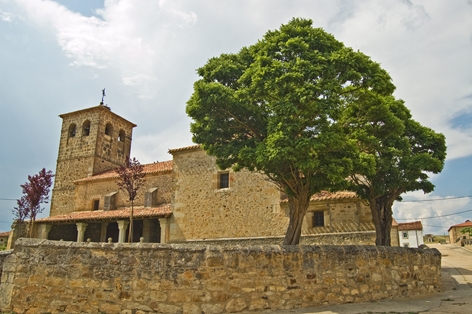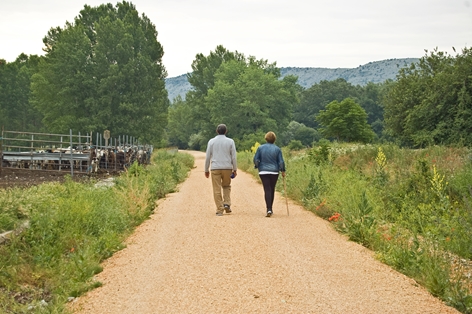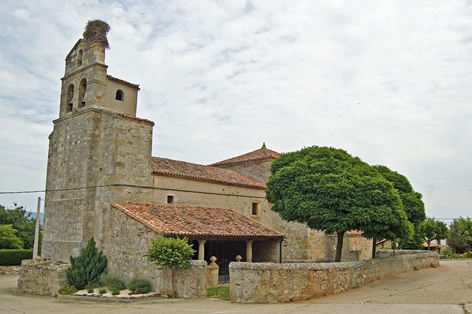- Home
- Rural Development
- Nature Trails
- Nature Trails
- Northwest Sector
- Santander-Mediterráneo
Santander-Mediterráneo Nature Trail. Abejar - Soria Section
Description

The Santander-Mediterranean Sea railway passes through beautiful pastures before reaching the capital of Soria.
The old railway approaches Soria in parallel to the Sierra de Cabrejas mountain range, leaving the nearby towns of Abejar, Herreros, Cidones, Ocenilla and Toledillo behind. A change in the livestock farming can be noted when passing from the pastures of Dehesa Robledal to Dehesa Golmayo. The Pico Frentes peak stands tall like a trusty watch tower at the end of the section, with the pleasant company of the River Golmayo, in the capital of Soria.

This section of the Santander-Mediterranean Sea Nature Trail starts in the old, 3rd class station of Abejar, which is found right next to kilometre point 0 (which is specifically next to the services hut). Behind the station, in the goods bay, the storage area with its three side gates and the Abejar rest area are located.
The trail goes past the first kilometre and reaches a crossroads, which if you take the left, will take you to the town of Abejar, which is permanently lined on the right by the Sierra de Cabrejas mountain range. This is included within the Natura 2000 Network as a Site of Community Importance (SCI) under the denomination of Sabinares Sierra de Cabrejas.

A little further along lies the town football pitch and the shrine of Nuestra Señora del Camino to the left. Following that, taking care, cross road SO-910.
You will continue along the old railway route, getting further away from the town of Abejar. Metres after kilometre point 4, you will head over a cattle grid, marking the entrance to the Dehesa Robledal pasture. Here you will find free roaming livestock, mainly cattle. The name 'Robledal' comes from the Spanish for oak (Quercus pyrenaica), and unsurprisingly that is the main tree species here, which is also known as Pyrenean oak. To a lesser extent, Scots pines (Pinus sylvestris) can also be found, alongside other herbaceous and shrub species that the livestock graze on.

With a slight incline which passes through a new patch of Pyrenean oaks, the sixth kilometre of this section is reached. Just before reaching kilometre point 8, one of the numerous crossroads that litter the route will point out the possibility of visiting the town of Herreros which is on the left hand side.
The railway sliding of Herreros can be found after passing yet another crossroads.
Keep continuing along the path, which is always lined on the right by the Sierra de Cabrejas mountain range. The landscape alternates with small plots of rain-fed crops with patches of mountain shrubs, species such as blackberry bushes (Rubus ulmifolius), gum rock rose (Cistus ladanifer), etc. and mountain trees, in which the oak tress dominate over the other species such as the Scots pine and ash trees (Fraxinus angustifolia), the latter of which is always found in the most humid areas.
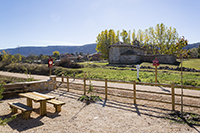
Metres before reaching kilometre point 12; an intersection highlights the proximity to the town of Villaverde del Monte, which can be reached by taking the path on the left. The incessant advance of the trail leads to kilometre point 14, where, not long afterwards, a new crossroads allows for the town of Cidones to be reached. Without respite, the 3rd class station of Cidones is reached to the right of the track.
The old route of the Santander-Mediterranean Sea railway reaches the town of Ocenilla, which sits to the right. Cross road SO-P-5030, taking great care, and you will get to the rest area where you can replenish your energy whilst also making the most of the proximity of the San Antonio shrine.
Leaving the town behind, the route continues up a gentle uphill, getting near to road N-234. At kilometre point 18, you will continue alongside said road for a few metres before distancing yourself from it once again along a comfortable downhill section. In just over a kilometre, at the bottom of the hill, an intersection points out the town of Toledillo, on the left of the trail.
After going past a swine livestock holding and kilometre point 12, the modest Toledillo stop is reached. The rest area here allows for the beautiful panoramic views of the Urbión, Cebollera and Carcaña mountain ranges to be enjoyed.

Once past kilometre point 22, the crossroads gives you the possibility of visiting the town of Fuentetoba. The 1.7 km that separate the Nature Trail from the town of Fuentetoba is surrounded by the Pico Frentes peak. Highlights of Fuentetoba include the Nuestra Señora de Valvanera shrine and the La Toba water spring, which is a wonderful site with water from the River Golmayo.
Once back on the trail, you will slowly move away from the Pico Frentes and pass through a cattle grid and various intersections to then enter the Dehesa de Golmayo pasture, where the cattle and the Pyrenean oak trees (Quercus pyrenaica) are the true stars. Leaving the pasture behind by crossing over another cattle grid, you will reach the detour which leads towards the town that the pasture is named after; Golmayo.
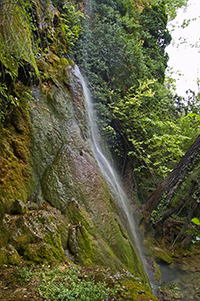
After passing under road N-122, the trail runs parallel to the River Golmayo, where you can enjoy the characteristic riverside vegetation. On the right there are small patches of holm oaks (Quercus ilex) that populate the area known as Royal de Arriba.
Without further ado, you will cross the SO-20 bypass by means of a bridge and not long after, this section of the Santander-Mediterranean Sea Nature Trail will come to an end in the rest area of Soria, with its characteristic information panel. Finally, it is worth pointing out the Senda del Duero Nature Trail that passes through the capital of Soria, as it invites you to continue travelling through the Castilian countryside.
Map
Puntos de Interés
Hidrografía
Información
Orografía
Profile

MIDE (Method for the Information of Excursions)
Featured
Further information
Soria
Capital loved by many writers, Antonio Machado being the most notable. The first settlements are found near to the Monte de Valonsadero mount, with the group of cave paintings of the Abrigo de Las Cobatillas. The city's greatest splendour was during the Middle Ages with the Honoured Council of the Mesta, as its economy revolved around the livestock activities. A host of monuments are spread out along the urban centre, which lies next to the River Duero, in which the reflection of the spectacular shrine of San Saturio can be seen. The rich gastronomy and different festivities that have been declared as Regional Touristic Interest complete the city's offerings, which bring all the senses to life.







